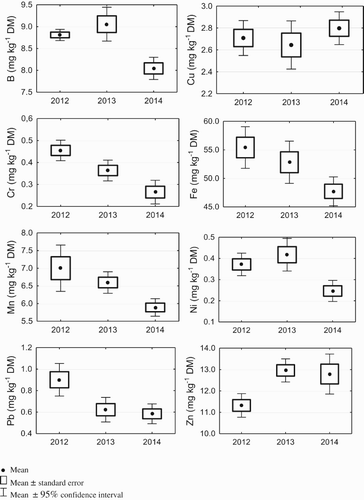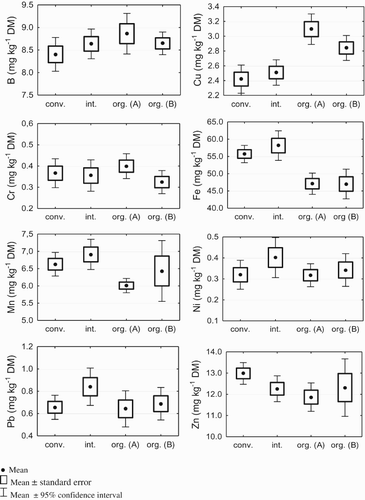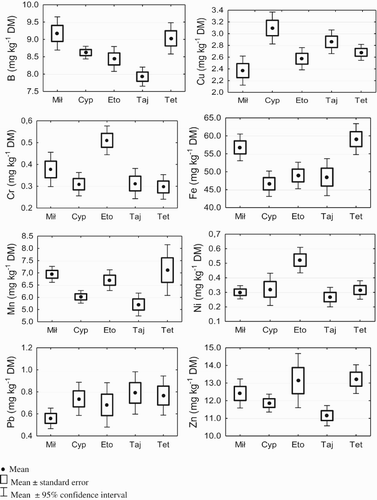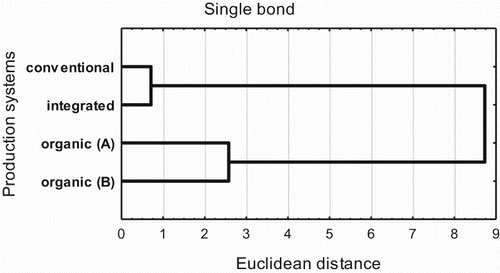ABSTRACT
The aim of this study was to determine the effect of different production systems (conventional, integrated and organic) on the content of micronutrients and trace elements in the tubers of very early, early and medium-early maturing potato cultivars. Five Polish potato cultivars were grown in three production systems under field conditions. In plant material selected microelements (chemical elements essential for living organisms) were analysed: boron (B), copper (Cu), iron (Fe), manganese (Mn) and zinc (Zn) as well as some trace elements (not regarded as essential element for living organisms): chromium (Cr), nickel, (Ni) and lead (Pb). The content of micronutrients and trace elements in potato tubers was modified by production system, genotype and weather conditions during the growing season. Organically grown potatoes had a higher content of B (8.6–8.9 mg kg−1) and Cu (2.8–3.1 mg kg−1), and a lower content of Fe (47.0–47.1 mg kg−1), Mn (6.0–6.4 mg kg−1) and Zn (11.9–12.2 mg kg−1), than potatoes grown in conventional and integrated systems. Potatoes grown in the conventional system had the highest Pb content. Organic cultivation can assure better alimentation of potato tubers with B and Cu, which are important microelements often deficient in the soils. On the contrary, when cultivating potato in conventional system, one should supply this element with fertilisers.
Introduction
Daily consumption of potatoes contributes to meeting mineral intake recommendations, mostly with regard to potassium (K), magnesium (Mg), copper (Cu), iron (Fe), manganese (Mn), selenium (Se) and zinc (Zn) (Nassar et al. Citation2012; Luis et al. Citation2011).
Potato tubers grow and develop in soil, but they do not accumulate large amounts of trace elements whose concentrations in potatoes are comparable with those noted in other vegetables. The content of trace elements in potato tubers is relatively low, but it may vary considerably across cultivars (Tack Citation2014). According to Haynes et al. (Citation2012), the micronutrient content of new potato cultivars can be increased through breeding since the uptake of Cu, Fe, Mn and Zn are affected by genetic factors. Potato cultivars display different tolerance towards various microelements content, e.g. excess boron stress (Ayvaz et al. Citation2016).
Food quality is one of the most important attribute of organic farming. Considerable differences between conventionally and organically grown potatoes have been observed with respect to their yield, tuber size, dry matter content and starch content. The factors that have a direct effect on consumers’ health include lower nitrate content and higher vitamin C content in organically grown potatoes (Hajšlová et al. Citation2005; Järvan and Edesi Citation2009).
Different systems of plant cultivation, including plant rotation and fertilisation can affect mineral composition of potato tubers. The reason for undertaking the research was the lack of experimental data concerning quality of potato tubers grown under various plant cultivation systems and carried out at the same time and in the same climatic and soil conditions. The aim of this study was to determine the effect of different production systems (conventional, integrated and organic) on the content of micronutrients and trace elements in the tubers of very early, early and medium-early maturing potato cultivars.
Materials and Methods
Field experiment
A field experiment was conducted in 2012–2014 in the Agricultural Experiment Station in Bałcyny (53° 35′ 49″ N, 19° 51′ 20″ E; Poland). Potatoes were grown in three production systems: conventional, integrated and organic with two variants (A and B) (). Five Polish potato edible cultivars: very early Miłek, early Cyprian and Etola, and medium-early Tajfun and Tetyda were grown in each of 6-field crop rotations.
Table 1. Potato production systems.
The field experiment was performed in triplicate. The experimental plots were located in a slightly undulating area, on Luvisol developed from sandy loam. Soil samples were analysed according to van Reeuwijk (Citation2002). Soil reaction (pH) was determined potentiometrically in water and in potassium chloride solution (1 M KCl dm−3). Total organic carbon was measured with a Vario Max Cube CN Elementar analyser. In the arable horizon, the clay fraction (ø < 0.002 mm) accounted for 2%–4%, and the silt fraction (ø 0.05–0.002 mm) – for 26%–39% (Rychcik et al. Citation2006). The soil was slightly acidic (pH in KCl 5.2–5.8); the available phosphorus content was very high and high; available potassium content was very high in conventional and integrated systems, and moderate in the organic system (). The content of Zn was high; the content of Cu and Mn was moderate and the content of B was low (Kabata-Pendias et al. Citation1993; ISSPC Citation1999).
Table 2. Selected properties of soil.
Potato cultivation technology
Ploughing was carried out in all systems. Manure was applied at 30 t ha−1 in autumn in integrated and organic (A and B) systems. Mineral fertilisers were applied in the conventional system: N – 150 kg ha−1 as 34% ammonium nitrate (90 kg N before seedling, 60 kg N in the 30–40 BBCH); P – 39.30 kg ha−1 as 17.5% superphosphate; K – 120 kg ha−1 as 50% potassium salt and in the integrated system: N – 100 kg ha−1 as 34% ammonium nitrate (60 kg N before seeding, 40 kg N in the 30–40 BBCH); P – 39.30 kg ha−1 as 17.5% superphosphate; K – 120 kg ha−1 as 50% potassium salt. Weeds, diseases and pests were controlled with synthetic pesticides in conventional and integrated systems. In the organic system, weeds were controlled mechanically, whereas diseases and pests were controlled with the use of plant production products allowed under Commission Regulation (EC) No. 889/2008. The forecrops were winter wheat in the conventional system, winter rye and winter triticale in the integrated system, and cereals followed by stubble catch crops in the organic system. Plot size in the crop rotation was 100 m2. Sprouted potato tubers were planted at a spacing of 0.625 × 0.400 m in the last 10 days of April and harvested in beginning of September.
Weather conditions varied across potato growing seasons (). In the growing seasons of 2012 and 2013, precipitation totals were similar to the long-term average, but they were not evenly distributed. In 2012, excess rainfall was observed in June and July (147 and 138% of the long-term average), whereas rainfall deficiency was noted towards the end of the growing season, particularly in August (36% of the 1961–2010 average). In 2013, excess rainfall was observed only in July (200% of the long-term average), whereas in the remaining months (except September) precipitation was below the long-term average, and August was particularly dry. The year 2014 was dry, with precipitation totals lower by 129.8 mm (35%) than the long-term average; only in June the amount of rainfall was comparable with the long-term average.
Table 3. Weather conditions during the study.
Mean air temperatures in April – September were 0.2°C lower in 2012, 0.5°C higher in 2013 and 0.4°C higher in 2014 compared with the long-term average. According to Boguszewska (Citation2006), optimal temperature between the last 10 days of June and the last 10 days of August, i.e. when peak potato yields are achieved, is 23°C–28°C during the day and 14°C–15°C during the night, with average daily temperature of 16°C–20°C. In Poland, rainfall deficiency is the main factor limiting potato yield. Temperature, precipitation amount and distribution affect the content of mineral nutrients in potato tubers, in particular Cu and Zn (Gugała et al. Citation2016, Citation2011; Zarzecka et al. Citation2016; Baranowska et al. Citation2017).
Chemical analysis methods
Tubers collected from 10 randomly selected potato plants were used for chemical analyses. After isolation the laboratory samples, plant material was dried in the temperature of 60°C in a dryer with forced air circulation, ground (laboratory grinder IKA WERKE M20), and wet mineralised (BÜCHI Speed Digester K-439) in a mixture of nitric (HNO3) acid and chloric (HClO4) acid (4:1 ratio) with the addition of hydrochloric acid (HCl). In plant material selected microelements (chemical elements essential for living organisms) were analysed: boron (B), copper (Cu), iron (Fe), manganese (Mn) and zinc (Zn) as well as some trace elements (not regarded as essential element for living organisms): chromium (Cr), nickel, (Ni) and lead (Pb). The content of Cu, Fe, Mn, Zn, Cr, Ni and Pb was determined by atomic absorption spectrophotometry (AAS) on a Shimadzu AA-6800 apparatus (Ostrowska et al. Citation1991). To determine B content, plant material was dry mineralised (520°C) in the presence of calcium oxide (CaO), and ash was dissolved in HCl (0.5 mol L−1). Boron content was determined colorimetrically on Shimadzu UV – 1201 V apparatus with the use of azomethine-H (Benedycka and Rusek Citation1994). All contents of chemical elements are expressed in dry matter (temperature of drying 105°C).
Data analysis
The results were analyzed statistically using STATISTICA 12 software. Differences between mean values were determined by Tukey's test at a significance level of p = 0.05. Cluster analysis involved agglomerative clustering (single-linkage), and the distance measure was Euclidean distance.
Results and discussion
In the present study, the concentrations of micronutrients and trace elements in potato tubers were affected by production system, variety's genotype, weather conditions during the growing seasons, and the interactions between the above factors (). Humidity and temperature did not affect the Cu content of potato tubers across experimental years (; ). The lowest concentration of Zn (11.32 mg kg−1 DM) and the highest concentrations of Cr, Fe, Mn, and Pb (0.46, 55.41, 7.04, and 0.90 mg kg−1 DM, respectively) in potato tubers were noted in the first year of the study (; ). The content of B, Cr, Fe, Mn, Ni and Pb in potato tubers was lowest and Cu and Zn the highest in the last year of the study.
Figure 1. Content of micronutrients and trace elements in potato tubers during the experimental years.

Table 4. Results of analysis of variance.
Table 5. Content of micronutrients and trace elements in potato tubers of the analyzed cultivars in different production systems (means of experimental years).
Organically grown potatoes had a higher content of B (8.65 and 8.86 mg kg−1 DM) and Cu (2.84 and 3.10 mg kg−1 DM), and a lower content of Fe (47.02 and 47.10 mg kg−1 DM), Mn (6.01 and 6.43 mg kg−1 DM) and Zn (11.87 and 12.22 mg kg−1 DM) in comparison with potatoes grown in conventional and integrated systems (, ). Pb content was highest (0.84 mg kg−1 DM) in potato tubers grown in the integrated system, and Cr content was highest (0.40 mg kg−1 DM) in potato tubers grown in variant A of the organic system. Production system did not affect the nickel content of potato tubers.
Figure 2. Content of micronutrients and trace elements in potato tubers in different production systems (explanation: conv. – conventional; int. – integrated; org. (A) – organic (A); org. (B) – organic (B)).

According to Lombardo et al. (Citation2014), farming system may influence the mineral profile of potato tubers. In the cited study, organically grown potatoes of early cultivars had Cu content (2.6 mg kg−1 DM) comparable with that noted in the conventional system. Conventionally produced potatoes had higher concentrations of Fe, Mn and Na. Other authors (Wszelaki et al. Citation2005; Sawicka et al. Citation2016) demonstrated that the content of Cu and Fe is often higher in organically grown potatoes, whereas Mn content is usually higher in the conventional system. This study proves that potato tubers cultivated in organic system contain more Cu, but less Fe and Mn than cultivated in conventional or integrated system. However, the complex interactions between minerals in soil and their effects and distribution in plants indicate that differences in the concentrations of mineral nutrients in potato tubers produced in different farming systems are not merely a consequence of the ‘dilution effect’ due to increased yield. The results of American studies show that organically grown potatoes have higher Cu content, lower concentrations of Fe and Na, and similar Zn content compared with conventionally produced potatoes (Griffiths et al. Citation2012). According to Sawicka et al. (Citation2016), crop production systems can modify the chemical composition of potato tubers. The organic management system contributes to higher accumulation of Fe in potato tubers, whereas Zn content is lower in organically grown potatoes than in those produced in the integrated system. However, potato cultivars vary in their reposes to the production system.
Potato production systems as well as the methods used to control diseases, weeds and pests can modify the mineral composition of potato tubers. Previous research has revealed that herbicides and their mixtures used in potato cultivation decrease Cu content, increase the concentrations of Fe and Mn, and have no influence on Zn content in tubers (Zarzecka et al. Citation2016). Herbicides applied alone and in combination with Kelpak SL and Asahi SL biostimulants contributed to an increase in the Zn content of potato tubers (Gugała et al. Citation2016). Selected insecticides can slightly decrease the concentrations of Cu and Zn in potato tubers (Gugała et al. Citation2011). Wierzbowska et al. (Citation2015) demonstrated that potato plants treated with the Kelpak SL biostimulant had higher concentrations of Zn, Mn, Fe and Cu than control plants, and the tubers of potato plants treated with Asahi SL had the highest B content. Bio-Algeen S90 lowered the accumulation of Zn, Mn, Fe and Cu in potato tubers. In a study by Baranowska et al. (Citation2017), the UGmax soil conditioner significantly reduced the Cu content of potato tubers.
Apart from environmental and agronomic factors, the variety's genotype also exerts a significant influence on the metal content of potato tubers (Sawicka et al. Citation2016). In the present experiment, the very early cultivar Miłek had the highest B content (9.17 mg kg−1 DM), and the lowest concentrations of Cu (2.37 mg kg−1 DM) and Pb (0.56 mg kg−1 DM) (, ). Potato tubers of the early cultivar Cyprian had the highest Cu content (3.10 mg kg−1 DM) and the lowest Fe content (46.65 mg kg−1 DM). Among the medium-early cultivars, Tajfun had lower concentrations of B, Mn, Zn and Ni (7.92, 5.71, 11.15 and 0.27 mg kg−1 DM, respectively), and tended to accumulate Pb. Tetyda was most abundant in Fe, Mn and Zn (59.09, 7.11 and 13.22 mg kg−1 DM, respectively). According to Flis et al. Citation2012 and Wekesa et al. Citation2014, certain groups of potato cultivars are known for their tendency to accumulate higher or lower amounts of minerals.
Figure 3. Content of micronutrients and trace elements in potato tubers of the analyzed cultivars (explanation: Mił – Miłek; Cyp – Cyprian; Eto – Etola; Taj – Tajfun; Tet – Tetyda).

In our study, irrespective of the production system and potato variety, the Fe:Mn ratio was 7.3–10.2:1, which according to Rogóż (Citation2009) points to Fe excess accompanied by Mn deficiency (). The Cu content of potato tubers ranged from 1.83 to 3.65 mg kg−1 DM, indicating copper deficiency according to the criterion proposed by Rogóż and Trąbczyńska (Citation2009) (>5 mg kg−1 DM).
This study revealed significant interactions between cultivar's genotypes and production systems for the content of micronutrients and trace elements in potato tubers ( and ). Cu content was significantly lowest in potato tubers of cultivar Miłek grown in the conventional system (1.83 mg kg−1 DM), and highest in potato tubers of cultivar Cyprian grown in variants A and B of the organic system (3.65 and 3.21 mg kg−1 DM, respectively). Potato tubers of cultivar Tajfun produced in the organic system (variant B) had the significantly lowest concentrations of Zn, Mn, Ni and Cr (10.27, 4.67, 0.16 and 0.24 mg kg−1 DM, respectively), whereas potato tubers of this cultivar grown in the integrated system had the lowest B content (7.76 mg kg−1 DM). Organically grown potatoes of cultivar Cyprian had the lowest Fe content (40.92 and 40,68 mg kg−1 DM). Potato tubers of cultivar Miłek grown in variant A of the organic system had the highest B content (10.14 mg kg−1 DM) and the lowest Pb content (0.41 mg kg−1 DM). Potato tubers of this cultivar produced in the conventional system had the highest Fe content (63.42 mg kg−1 DM). Potato tubers of cultivar Etola had the highest Zn content (14.30 mg kg−1 DM) when grown in the integrated system, and the highest Cr content when produced in conventional and organic (variant A) systems.
Subramanian et al. (Citation2011) reported that the three-dimensional distribution of mineral elements in potato tubers was uneven. The concentrations of most minerals were higher in the skin than in the flesh of tubers. The potato skin contained approximately 17% of total tuber Zn and 55% of total tuber Fe. When analyzed on a fresh weight basis, the concentrations of most minerals were higher at the stem end of the tuber. The concentration of Cu decreased from the periphery towards the centre of the tuber. Šrek et al. (Citation2012) also found higher concentrations of many micronutrients (Cd, Cr, Cu, Mn, Ni and Zn) in potato peels than in peeled tubers, but the differences regarding trace elements were relatively small. In a study by Petryk and Bedla (Citation2010), the concentrations of Zn and Fe in the potato peel were 30.8–68.9 mg kg−1 and 79.8–211.3 mg kg−1 DM, respectively, whereas the respective values determined in the tuber flesh were 18.8–48.3 mg Zn kg−1 DM and 20.0–44.7 mg Fe kg−1 DM.
Two groups of production systems exerting different effects on the content of micronutrients and trace elements in potato tubers were identified in the cluster analysis (). The mineral composition of potatoes grown in conventional and integrated systems, which formed the first cluster, was very similar. The other cluster comprised variants A and B of the organic system, but in this case the mineral content of potato tubers was more varied.
Disclosure statement
No potential conflict of interest was reported by the authors.
Notes on contributors
Jadwiga Wierzbowska – PhD, is an associate professor at Department of Agricultural Chemistry and Environmental Protection, University of Warmia and Mazury in Olsztyn, Poland. Her fields of research include plant nutrition investigations in relation to crop quality and soil fertility.
Bogumił Rychcik – PhD in agricultural sciences. He works at Department of Agroecosystems, University of Warmia and Mazury in Olsztyn, Poland. His research interests focus is on plant production under different cropping systems, particularly in organic farming.
Arkadiusz Światły – PhD student at Department of Agricultural Chemistry and Environmental Protection, University of Warmia and Mazury in Olsztyn, Poland.
Additional information
Funding
References
- Ayvaz M, Guven A, Blokhina O, Fagerstedt KV. 2016. Born stress, oxidative damage and antioxidant protection in potato cultivars (Solanum tuberosum L.). Acta Agic Scand B. 66:302–316.
- Baranowska A, Zarzecka K, Gugała M, Mystkowska I. 2017. Contents of zinc, copper and manganese in potato tubers depending on the ways of application of the soil fertilizer UGmax. J Ecol Eng. 18:99–106. doi: 10.12911/22998993/66250
- Benedycka Z, Rusek E. 1994. Suitability of a method using azomethine-H in determining boron in plant and soil. Acta Acad Agricult Techn Olst. 58:85–90.
- Boguszewska D. 2006. Poland's climate change in 1983–2002 and prospects for potato cultivation. Ziemniak Polski. 3:19–22.
- Flis B, Zimnoch-Guzowska E, Mańkowski D. 2012. Correlations among yield, taste, tuber characteristics and mineral contents of potato cultivars grown at different growing conditions. J Agr Sci. 4:197–207.
- Griffiths AM, Cook DM, Eggett DL. 2012. A retail market study of organic and conventional potatoes (Solanum tuberosum): mineral content and nutritional implications. Int J Food Sci Nutr. 63:393–401. doi: 10.3109/09637486.2011.629602
- Gugała M, Zarzecka K, Mystkowska I. 2011. Copper and zinc contents in edible potato tubers influenced by an application of new generation insecticides. Fresen Environ Bull. 20:1–4.
- Gugała M, Zarzecka K, Sikorska A, Dołęga H, Kapela K, Krasnodębska E. 2016. The impact of methods of care on the content and collection of zinc and copper with the yield of potato tubers. J Ecol Eng. 17:289–294. doi: 10.12911/22998993/64500
- Hajšlová J, Schulzová V, Slanina P, Janné K, Hellenäs KE, Andersson C. 2005. Quality of organically and conventionally grown potatoes: four-year study of micronutrients, metals, secondary metabolites, enzymic browning and organoleptic properties. Food Addit Contam. 22:514–534. doi: 10.1080/02652030500137827
- Haynes KG, Yencho GC, Clough ME, Henninger MR, Sterrett SB. 2012. Genetic variation for potato tuber micronutrient content and implications for biofortification of potatoes to reduce micronutrient malnutrition. Am J Pot Res. 89:192–198. doi: 10.1007/s12230-012-9242-7
- [ISSPC] Institute of Soil Science and Plant Cultivation (ISSPC), Puławy, Poland. 1999. Fertilization recommendations. Part I. Threshold values for determination of macro- and micronutrients in soils. Ser. P(44), 26 pp. (in Polish).
- Järvan M, Edesi L. 2009. The effect of cultivation methods on the yield and biological quality of potato. Agron Res. 7(Special issue I):289–299.
- Kabata-Pendias A, Motowicka-Terelak T, Piotrowska M, Terelak H, Witek T. 1993. Estimation of the level of soil and plant contamination with heavy metal and sulfur. Institute of Soil Science and Plant Cultivation, Puławy, Poland, Ser. P(53), 20 pp. (in Polish).
- Lombardo S, Pandino G, Mauromicale G. 2014. The mineral profile in organically and conventionally grown “early” crop potato tubers. Sci Horticult. 167:169–173. doi: 10.1016/j.scienta.2014.01.006
- Luis G, Rubio C, Gonzalez-Weller D, Gutierrez AJ, Revert C, Hardisson A. 2011. Comparative study of the mineral composition of several varieties of potatoes (Solanum tuberosum L.) from different countries cultivated in Canary Islands (Spain). Int J Food Sci Tech. 46:774–780. doi: 10.1111/j.1365-2621.2011.02556.x
- Nassar AMK, Sabally K, Kubow S, Leclerc YN, Donnelly DJ. 2012. Some Canadian-grown potato cultivars contribute to a substantial content of essential dietary minerals. J Agric Food Chem. 60:4688–4696. doi: 10.1021/jf204940t
- Ostrowska A, Gawliński S, Szczubiałka Z. 1991. Methods of analysis and assessment of soil and plant properties. Warszawa: Institute of Environmental Protection. 334 pp. (in Polish).
- Petryk A, Bedla D. 2010. Evaluation of heavy metals (Pb, Zn, Cr, Fe) content in potatoe’s tuber and in soil in the Trzebinia municipality. Inżynieria Ekologiczna. 22:18–24.
- Rogóż A. 2009. Trace element content in soils and in selected root crops. Part II. Manganese and iron content. Zesz Probl Post Nauk Rol. 541:365–373.
- Rogóż A, Trąbczyńska K. 2009. Trace element content in soils and in selected root crops. Part I. The content of copper and zinc. Zesz Prob Post Nauk Rol. 541:353–363.
- Rychcik B, Adamiak J, Wójciak H. 2006. Dynamics of the soil organic matter in crop rotation and long-term monoculture. Plant Soil Environ. 52(Special Issue):15–20.
- Sawicka B, Barbaś P, Skiba D. 2016. Fluctuations of sodium, copper, zinc, iron and manganese in potato tubers in the organic and integrated production system. J Elem. 21:539–547.
- Subramanian NK, White PJ, Broadley MR, Ramsay G. 2011. The three-dimensional distribution of minerals in potato tubers. Ann Bot. 107:681–691. doi: 10.1093/aob/mcr009
- Šrek P, Hejcman M, Kunzová E. 2012. Effect of long-term cattle slurry and mineral N, P and K application on concentrations of N, P, K, Ca, Mg, As, Cd, Cr, Cu, Mn, Ni, Pb and Zn in peeled potato tubers and peels. Plant Soil Environ. 58:167–173. doi: 10.17221/610/2011-PSE
- Tack FMG. 2014. Trace elements in potato. Potato Res. 57:311–325. doi: 10.1007/s11540-014-9268-y
- van Reeuwijk LP. 2002. Procedures for soil analysis, 6th ed. Technical Papers 9. Wageningen: ISRIC – World Soil Information.
- Wekesa MN, Okoth MW, Abong GO, Muthoni J, Kabira JN. 2014. Effect of soil characteristics on potato tuber minerals composition of selected Kenyan varieties. J Agr Sci. 6:163–171.
- Wierzbowska J, Cwalina-Ambroziak B, Bowszys T, Głosek-Sobieraj M, Mackiewicz-Walec E. 2015. Content of microelements in tubers of potato treated with biostimulators. Pol J Natur Sc. 30:225–234.
- Wszelaki AL, Delwiche JF, Walker SD, Liggett RE, Scheerens JC, Kleinhenz MD. 2005. Sensory quality and mineral and glycoalkaloid concentrations in organically and conventionally grown redskin potatoes (Solanum tuberosum). J Sci Food Agr. 85:720–726. doi: 10.1002/jsfa.2051
- Zarzecka K, Gugała M, Baranowska A, Dołęga H, Sikorska A. 2016. Concentrations of copper, zinc and manganese in potato tubers under the influence of herbicides. J Elem. 21:259–267.

